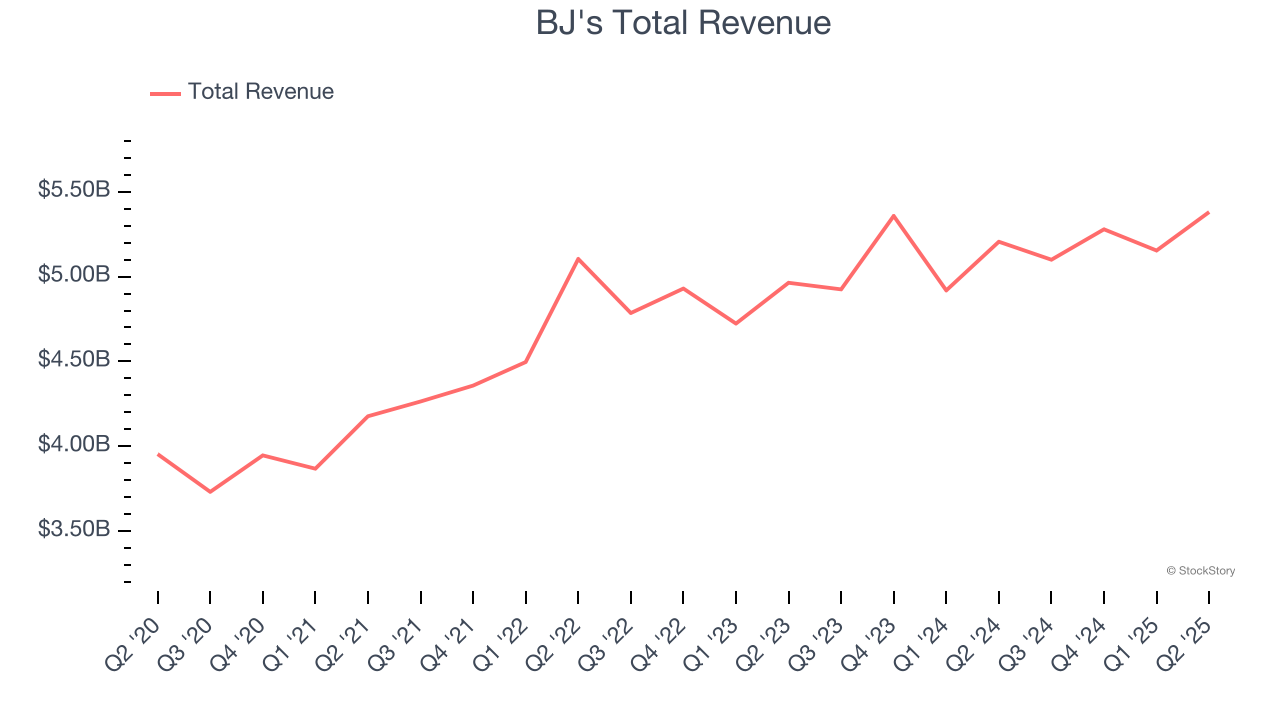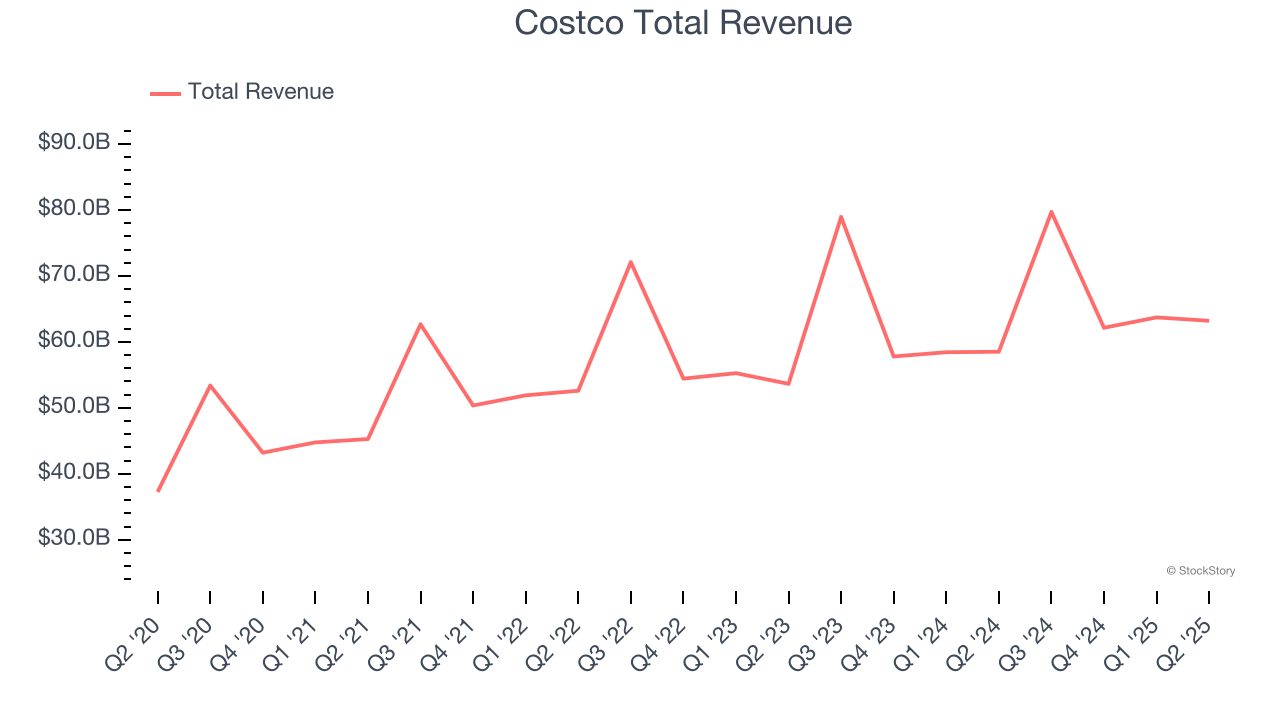
The end of the earnings season is always a good time to take a step back and see who shined (and who not so much). Let’s take a look at how large-format grocery & general merchandise retailer stocks fared in Q2, starting with BJ's (NYSE:BJ).
Big-box retailers operate large stores that sell groceries and general merchandise at highly competitive prices. Because of their scale and resulting purchasing power, these big-box retailers–with annual sales in the tens to hundreds of billions of dollars–are able to get attractive volume discounts and sell at often the lowest prices. While e-commerce is a threat, these retailers have been able to weather the storm by either providing a unique in-store shopping experience or by reinvesting their hefty profits into omnichannel investments.
The 4 large-format grocery & general merchandise retailer stocks we track reported a mixed Q2. As a group, revenues along with next quarter’s revenue guidance were in line with analysts’ consensus estimates.
Amidst this news, share prices of the companies have had a rough stretch. On average, they are down 7.2% since the latest earnings results.
Weakest Q2: BJ's (NYSE:BJ)
Appealing to the budget-conscious individual shopping for a household, BJ’s Wholesale Club (NYSE:BJ) is a membership-only retail chain that sells groceries, appliances, electronics, and household items, often in bulk quantities.
BJ's reported revenues of $5.38 billion, up 3.4% year on year. This print fell short of analysts’ expectations by 1.9%. Overall, it was a slower quarter for the company with full-year EPS guidance slightly missing analysts’ expectations.

BJ's delivered the weakest performance against analyst estimates of the whole group. Unsurprisingly, the stock is down 8.1% since reporting and currently trades at $97.61.
Read our full report on BJ's here, it’s free.
Best Q2: Costco (NASDAQ:COST)
Designed to be a one-stop shop for the suburban consumer, Costco (NASDAQ:COST) is a membership-only retail chain that sells groceries, apparel, toys, and household items, often in bulk quantities.
Costco reported revenues of $63.21 billion, up 8% year on year, in line with analysts’ expectations. The business had a satisfactory quarter with an impressive beat of analysts’ gross margin estimates.

Costco pulled off the fastest revenue growth among its peers. Although it had a fine quarter compared its peers, the market seems unhappy with the results as the stock is down 6.4% since reporting. It currently trades at $942.44.
Is now the time to buy Costco? Access our full analysis of the earnings results here, it’s free.
Walmart (NYSE:WMT)
Known for its large-format Supercenters, Walmart (NYSE:WMT) is a retail pioneer that serves a budget-conscious consumer who is looking for a wide range of products under one roof.
Walmart reported revenues of $177.4 billion, up 4.8% year on year, exceeding analysts’ expectations by 0.8%. Still, it was a slower quarter as it posted a significant miss of analysts’ EBITDA estimates.
As expected, the stock is down 5.5% since the results and currently trades at $96.87.
Read our full analysis of Walmart’s results here.
Target (NYSE:TGT)
With a higher focus on style and aesthetics compared to other large general merchandise retailers, Target (NYSE:TGT) serves the suburban consumer who is looking for a wide range of products under one roof.
Target reported revenues of $25.21 billion, flat year on year. This number topped analysts’ expectations by 1.3%. Aside from that, it was a mixed quarter as it also logged full-year EPS guidance exceeding analysts’ expectations but a significant miss of analysts’ EBITDA estimates.
Target achieved the biggest analyst estimates beat but had the slowest revenue growth among its peers. The stock is down 8.8% since reporting and currently trades at $96.15.
Read our full, actionable report on Target here, it’s free.
Market Update
In response to the Fed’s rate hikes in 2022 and 2023, inflation has been gradually trending down from its post-pandemic peak, trending closer to the Fed’s 2% target. Despite higher borrowing costs, the economy has avoided flashing recessionary signals. This is the much-desired soft landing that many investors hoped for. The recent rate cuts (0.5% in September and 0.25% in November 2024) have bolstered the stock market, making 2024 a strong year for equities. Donald Trump’s presidential win in November sparked additional market gains, sending indices to record highs in the days following his victory. However, debates continue over possible tariffs and corporate tax adjustments, raising questions about economic stability in 2025.
Want to invest in winners with rock-solid fundamentals? Check out our Top 6 Stocks and add them to your watchlist. These companies are poised for growth regardless of the political or macroeconomic climate.
StockStory is growing and hiring equity analyst and marketing roles. Are you a 0 to 1 builder passionate about the markets and AI? See the open roles here.
